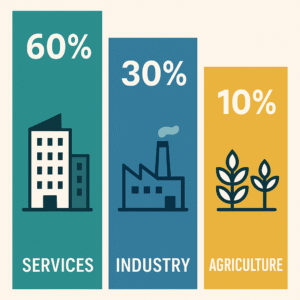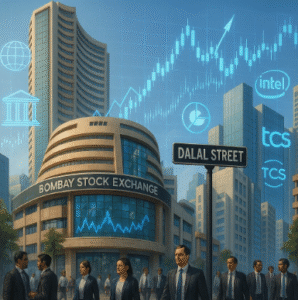Maharashtra has always been at the forefront of India’s economic story. Home to Mumbai, the country’s financial capital, and Pune, its technology and education hub, the state stands as a model of scale, diversity, and resilience. In the post-pandemic years, Maharashtra has not only retained its lead but has widened the gap with most other states in terms of economic contribution.
According to the Maharashtra Economic Survey 2024–25, the state’s economy is projected to grow at 7.3%, outpacing the national average. This robust momentum is driven by a dynamic services sector, thriving industry, and steady agricultural output – a combination that gives Maharashtra one of the most balanced economic portfolios in the country.
The GDP Engine
Maharashtra is currently working towards an ambitious goal: becoming a $1 trillion economy by 2030, with a long-term vision of reaching $5 trillion by 2047. Today, the state accounts for the highest Gross State Domestic Product (GSDP) in India. The services sector dominates with roughly 60% of output, followed by industry at around 30%, and agriculture making up the rest.
But the distribution of economic activity is far from uniform. Just seven districts, including Mumbai, Pune, Thane, and Nagpur, account for more than half of Maharashtra’s total GSDP. Mumbai alone contributes around 20%, underscoring its central role as a financial and trade hub.

Financial Nerve Centre of India
Mumbai’s Dalal Street is home to the Bombay Stock Exchange (BSE) and the National Stock Exchange (NSE) – both critical for the functioning of India’s capital markets. Several Nifty 50 companies are headquartered in the state, spanning banking, IT, FMCG, and manufacturing. This concentration of corporate power ensures a steady flow of investment, jobs, and innovation into the local economy.
Maharashtra is also a leader in attracting foreign direct investment. In FY 2024–25, it secured a record ₹1.65 lakh crore in FDI, about 40% of the total inflows into India. Over the past two years, it has consistently topped the charts in FDI attractiveness.

Industry & Infrastructure
Beyond finance, Maharashtra is an industrial giant. Manufacturing hubs in Pune, Aurangabad, Nashik, and Nagpur drive automobile, electronics, engineering, and food processing output. Emerging projects are set to further transform the state’s industrial landscape, such as the development of Gadchiroli into a steel hub with investments exceeding ₹1 lakh crore.
Infrastructure development is equally aggressive. From the Mumbai Trans Harbour Link to the Pune Ring Road and Nagpur–Mumbai Samruddhi Expressway, these projects are reducing logistics costs and linking economic zones more efficiently. Industrial corridors like Auric City and port expansions at Dighi and JNPT are boosting export potential.
The Services Dominance
Maharashtra’s services sector is its strongest growth pillar. Information technology, global capability centres (GCCs), financial services, film and entertainment, and tourism collectively give the state its competitive edge. Pune has become a magnet for IT and R&D, hosting global names and fostering a thriving startup culture.
To capitalise on this momentum, the Maharashtra Startup Policy 2025 aims to create 50,000 startups and 1.25 lakh entrepreneurs over the next five years. This will be supported by a ₹500 crore “Maha-Fund” and the development of innovation hubs.
Agriculture’s Role
Agriculture employs over half the state’s workforce but contributes only about 13% to GSDP. Key crops include sugarcane, cotton, soybean, and horticultural products like grapes and pomegranates. While yield improvements and irrigation projects are underway, rural incomes still lag urban ones, and regional disparities remain a challenge.
Balancing Growth & Equity
Despite its economic heft, Maharashtra faces stark inequalities. Twenty-seven districts have per capita incomes below the state average, and twelve are even below the national average. The government is now rolling out district-level five-year plans to target infrastructure, education, and industrial investments in these underserved areas.
The Road Ahead
Maharashtra’s growth model blends financial leadership, industrial expansion, and service sector innovation. But to achieve its $1 trillion goal, it must address regional imbalances, improve agricultural productivity, and keep pace with infrastructure needs.
With a clear policy direction, strong investor confidence, and an unmatched concentration of corporate headquarters, Maharashtra is set to remain the powerhouse of India’s economy, the state that not only drives the country’s GDP but also shapes its financial future.
Contributor: Team Leveraged Growth



